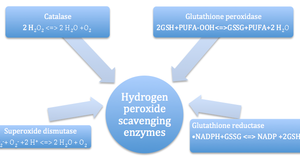From Discussions VOL. 8 NO. 2The Contribution of HPG Axis-Hormones and Hormone Replacement Timing on Cognition and Associated Signaling
IN THIS ARTICLE
KEYWORDS
AbstractMany women experiencing menopause show cognitive function deficits and have an increased risk of developing Alzheimer's Disease (AD). While estrogen (E2) has been shown to improve cognition and improve molecular signaling associated with learning and memory, these effects are lost if estrogen replacement is not started within a critical time period, close to menopause onset. During menopause the ovaries no longer produce estrogen. Thus, the negative feedback of estrogen onto gonadotropin production is lost, and gonadotropins such as Luteinizing Hormone (LH) increase substantially. The downregulation of LH (in the absence of E2) leads to cognitive improvements identical to those observed when E2 is administered right at the onset of menopause. This study attempts to find data on the changes in signaling proteins that are important for learning and memory. In order to test the hypothesis that cognitive changes after menopause are primarily driven by increases in LH not decreases in estrogen levels, mice were treated with LH regulators in the short-term, soon after menopausal onset, and in the long-term. They were then tested for levels of protein expression in the hippocampal area of the brain. This experiment attempts to determine whether the signaling molecules being studied are controlled by the menopausal state and other treatments. It determines whether estrogen's actions on these signaling cascades are independent of its ability to downregulate luteinizing hormone and whether the loss of effectiveness of E2 on cognition when treatment onset begins long after menopause is related to changes in these signaling cascades. The data reveals LA is better at downregulating LH than E2, especially in the long-term, and that the tested signaling molecules are affected by aging. The results are relevant in not only determining the effects of hormones and aging on the learning and memory process but also finding preventative measures for neural degenerative disorders such as Alzheimer's disease.
Alzheimer's disease (AD) is an age-related, degenerative disorder that attacks nerve cells in the brain resulting in memory loss, decrease in thinking and language skills, and behavioral changes. Sex steroid hormones are regulators of neuron survival in multiple Central Nervous System regions and across a variety of circumstances ranging from normal development to neural injury [1]. The progressive decrease in sex steroids with age is an important factor for age-related Alzheimer's disease [1]. Hormones are not only a significant part of the endocrine system but are also important in neural processes such as cognition. In women, the hormone estrogen plays a huge role in modulating the signaling cascades involved in cognition and regulating the signaling molecules involved in the processes of learning and memory. Abundant experimental, epidemiological and clinical evidence suggest that neural action estrogens can reduce the risk for AD [1]. This is evident in the increased risks of cognitive disorders that develop after menopause. In women, the age-related decrease in sex steroids is characterized by menopause via estrogen (E2). Women experiencing menopause have a tendency to show cognitive function deficits and are at risk of developing neurodegenerative diseases. In the hypothalamic-pituitary-gonadal (HPG) axis, the neurons within the hypothalamus release Gonadotropin-releasing Hormones (GnRH) to the anterior pituitary, which synthesizes and secretes the gonadotropin Luteinizing Hormone (LH). Normally in women, the ovaries produce estrogen which is part of the negative feedback loop to the hypothalamus in the brain. This results in an overall decrease in LH production. During menopause, the negative feedback of estrogen onto gonadotropin production is lost because estrogen is no longer being produced. As such, gonadotropins, for example luteinizing hormone (LH), increase substantially. The post-menopausal changes in E2 and LH levels have been associated with increased risk and development of AD and cognitive impairment [2, 3]. Conversely, the normalization of these hormones to physiological levels leads to cognitive improvement [4]. Hormone replacement therapy can artificially boost hormone levels, possibly prolonging life and reducing the incidence of dementia. Therefore if E2 replacement is administered at the onset of menopause, the treatment is effective; however, as the time interval between menopause onset and treatment increases, estrogen loses its ability to downregulate LH [3]. In the absence of E2, the drug Leuprolide Acetate (LA) can specifically downregulate elevations in the gonadotropin, LH, and can be used to differentiate estrogen from LH effects on neuronal function [5]. The gonadotropin releasing hormone antagonist can also improve cognitive function, and increase levels and phosphorylation of signaling molecules associated with the modulation of cognition [3]. This suggests that high LH, not low estrogen, is the primary driver of cognitive changes during menopause. Elevations of serum LH occur during and after menopause. LH fluctuations have also been linked to cognitive deficits, AD predisposition, and decreased cognitionassociated intracellular signaling [5]. Hormones such as estrogen are known to modulate cognition through a variety of intracellular cascades that are important in the formation and stabilization of long-term memories [6, 7]. Estrogen directly influences brain function through estrogen receptors located on neurons in multiple areas of the brain [14, 15]. The hormone also appears to have direct membrane-mediated effects on neurons. Its effects are both neuroprotective and neurotrophic [15]. Estrogen has been shown to protect isolated neurons in vitro from damage by amyloid protein, which is implicated in the pathogenesis of Alzheimer's disease [15]. At neuronal synapses, estrogen increases the concentration of neurotransmitters such as serotonin, dopamine, and norepinephrine [16]. It affects their release, reuptake, and enzymatic inactivation. It also increases the number of receptors for these neurotransmitters [15]. Synaptophysin and synapsin are both important molecules in the regulation of synaptic release and are both associated with improvements in memory function [10, 11]. Synaptophysin (SYP) is a calcium-binding glycoprotein found in the membranes of neurotransmitter-containing presynaptic vesicles, and it is believed to modulate the efficiency of synaptic vesicle cycles. Normally, synaptophysin decreases with age in the hippocampus and various cortical regions. Synapsin is an abundant brain protein essential for regulating neurotransmitter release. Phosphorylation of synapsin by PKA or CaM Kinase I inhibits its binding to phospholipids and dissociates synapsin from synaptic vesicles [17]. Synapsin I is an exclusively presynaptic protein, so its deletion can block the enhancements of learning, presynaptic plasticity, and Long Term Potentiation (LTP) [11]. Memory is created by the persistent modification of strength of synapses. One such modification is LTP which occurs in the hippocampus. LTP has associative properties that match the process of learning. Once it is triggered by the rise in postsynaptic calcium, modification can be maintained for up to an hour [8]. In order to facilitate both LTP and the formation of new memories, glutamate receptor 1 (GluR1), an important subunit of the AMPA receptor, must be phosphorylated at amino acid Ser845, which leads to the mobilization of the AMPA receptor from the post-synaptic density to the synapse [6, 9, 18]. Signaling events, such as the autophosphorylation of calciumcalmodulin kinase II (CAMKII), lead to the phosphorylation of GluR1 [9]. The maintenance of AMPA receptors is due to the ability of CaMKII to maintain its activity for long periods of time after its initial activation by calcium. CaMKII is a critical protein in LTP because it has special properties which make it exhibit persistent changes. Women experience both elevations in LH and declines in estrogen during and after menopause. Similarly, after ovariectomy (OVX), rodents also have elevations in LH and declines in estrogen providing a good model to study hypothalamic-pituitary-gonadal-axis hormonecognition interactions [12] as well as the learning and memory signaling cascades. It is unknown if the changes in signaling cascades are related to 1) whether the signaling molecules studied are modulated by menopausal state and our treatments, 2) whether E2 actions on these signaling cascades are independent of its ability to downregulate LH, and 3) whether loss of effectiveness of E2 on cognition when treatment onset begins long after menopause. Therefore, it is the goal of this project is to study the changes in the signaling proteins important for learning and memory to determine such relationships. Materials and MethodsAnimals: Female, 8 month-old C57/BL6 mice were ovariectomized (OVX) and treated with saline (SAL), Leuprolide Acetate (LA) (7.5 mg/kg SC) (for the downregulation of LH) and E2 (5ug SC) for 3 months. The SAL treatment is also known as OVX and will be used interchangeably. This treatment emulated the symptoms of menopause. For the short-term treatments, the drugs administered immediately after surgery from months 1 to 3. For the long-term treatments, drugs were administered 4 months after surgery to determine effects of treatment timing. The SHAM mice served as a control since they did not experience menopausal conditions. Tissue processing and Western Blots: For western blot analysis, hippocampus tissue was homogenized, and protein levels were determined for approximately 16 samples. The hippocampus was chosen for testing because it is the center of the brain associated with memory and cognition. 20ug aliquots of tissue were loaded and separated by electrophoresis on 8% acrylamide gels. Primary antibodies of both phosphoand total CaM Kinase II (Promega), synaptophysin (Invitrogen), and phospho-Synapsin (Calbiochem) were used in dilutions of 1:5000, 1:1000, and1:200 respectively. Gels were then transferred to PVDF membranes, probed with rabbit antibody, and visualized using a chemiluminescence-based detection (Denville). The blots were compared to the loading-control protein actin, which is expressed at a constant level regardless of the treatment applied to the original organism. Quantification Western blots of both the tested proteins as well as the actin were quantified by densiometric measurements using ImageJ (NIH) data analyzed by ANOVA and posthoc comparisons.Continued on Next Page » Suggested Reading from Inquiries Journal
Inquiries Journal provides undergraduate and graduate students around the world a platform for the wide dissemination of academic work over a range of core disciplines. Representing the work of students from hundreds of institutions around the globe, Inquiries Journal's large database of academic articles is completely free. Learn more | Blog | Submit Latest in Biology |















